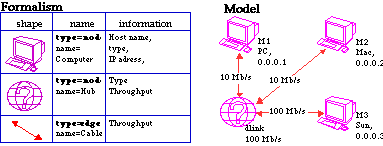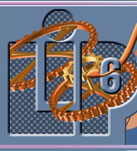Models
in FrameKit
To deal with graphical representations FrameKit distinguishes
two notions, formalism and model:
- A formalism describes a representation
rules of a knowledge domain;
- A model is an instance of formalism (Figure 1). It is one representation
expressed using the related formalisms.
Models are formalism instances. A «tool palette» can be easily
deduced from the formalism description. Its goal is to present the set
of items that can be instanciated in a model. A model is the basic component
on which users may apply services.
Model
and Formalisms
Figure 1 shows the relation between a formalism (on the left) and a model
associated to this formalism (on the right). A simple formalism dedicated
to the description of a local network is defined on the left. It has three
classes: two nodes («computer» and «hub») and one
edge («link»). On the right a model designed according these
rules is presented. Any object is identified by means of a set of labels
(attributes in the sense of OO technology).

Figure 1 : Example of model associated to a formalism.
Hierarchical Models
Formalisms may be composed when they are hierarchical. In that case,
some nodes are associated to another formalism. These nodes are called
«boxes» and can be «opened» (when double clicking)
to display its content in a new submodel.

Figure 2 : Example of hierarchical model.
Figure 2 is an example of hierarchical model made with the NET formalism
(described in the formalism section).
It is composed of three submodels (called pages in Macao). the main one
is a NET, the two others ("small net" and "locnet#2") are LOCNETs.
|









